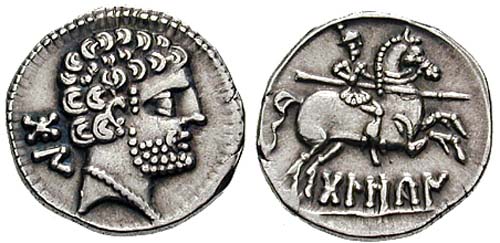All entries for Monday 10 June 2013
June 10, 2013
Osca and Iconographic Entanglement
 |
| An Iberian denarius from Osca. |
In examining how the Romans represented themselves and their growing Empire, it is clear that ideology and iconography arose from the interaction Rome had with her provinces. As Dietler disccusses in his book Archaeologies of Colonialism, any colonial or cultural encounter does not just affect the people being conquered, but also the conqueror. Both sides are transformed by these encounters, in a process called entanglement.
Entanglement(s) between the Roman Republic and other areas can be traced on numerous coin issues. Of interest here are the coin issues of Osca in Spain (modern day Huesca, but called Bolskan in the local Iberian language). Osca is perhaps best known for connection with the Roman rebel Quintus Sertorius, who made Osca his base and established a school to educate the children of local chieftans in the Roman manner. Osca also struck 'Iberian denarii', a series of silver coins carrying Iberian legends that were struck by numerous mints in Spain after the Roman conquest. The motivation behind these coins is heavily debated in modern scholarship, but they can be connected with the Roman conquest, and were in all likelihood used by the Romans in Spain. Although struck by numerous mints and different tribal gorups, these coins all carried a common iconography: a male head on the obverse, and a horseman on the reverse.
 |
| Coin of Gnaeus Domitius Calvinus, struck at Osca |
In 40 BC Gnaeus Domitius Calvinus was sent as governer to Spain by Octavian. Calvinus remained in Spain for three years and appears to have been military successful. Calvinus had supported Julius Caesar during the civil wars, and after Caesar's death he supported Octavian. While in Spain, Domitius Calvinus struck Roman denarii (RRC 532/1) with a male head on the obverse and pontifical emblems on the reverse. The obverse type is clearly inspired by local Oscan issues (also referenced with the legend OSCA). The Roman conquest had sparked the issue of Iberian denarii at Osca, which in turn influenced the official Roman coinage struck by Roman officials - a case of entanglement. The reverse type was believed by Crawford to refer to Calvinus' position as a member of the Roman priesthood. The image, however, may have an alternative reference. Given Calvinus' long term support of the Caesarian cause, it may be a reference to the famous elephant and pontifical emblems coin of Caesar. This was one of the most prolific Republican denarius issues ever struck, meaning its imagery would be known and recognised. Others had referenced Caesar's coin as a statement of their political alliances (see the case of Hirtius), and Domitius Calvinus may be doing so in a subtle manner here. The imagery on the coin may thus have multiple layers of interpretation and meaning - it might be read as a statement of individual political loyalty, individual prestige, and as the product of entanglement between the Roman Republic and her provinces.
(Coin images reproduced courtesy of Classical Numismatic Group Inc., (www.cngcoins.com) and Numismatica Ars Classica NAC AG).
 Clare Rowan
Clare Rowan

 Please wait - comments are loading
Please wait - comments are loading

 Loading…
Loading…